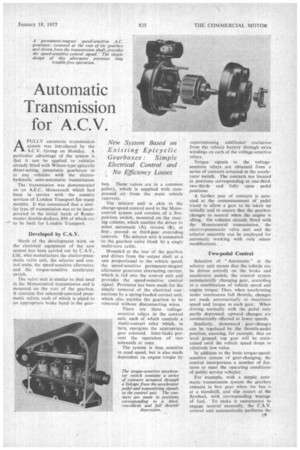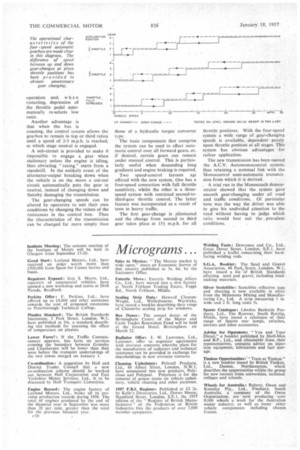Automatic Transmission for A.C.V.
Page 49

Page 50

If you've noticed an error in this article please click here to report it so we can fix it.
AFULLY automatic transmission system was introduced by the A.C.V. Group on Monday. A particular advantage of the system is that it can be applied to vehicles already fitted with Wilson-type epicyclic direct-acting, pneumatic gearboxes or to any vehicles with the electrohydraulic semi-automatic transmission.
The transmission was demonstrated on an A.E.C. Monocoach which had been in service with the country services of London Transport for many months. It was announced that a similar type of transmission was to be incorporated in the initial batch of Routemaster double-deckers, 850 of which are --to be built for London Transport.
Developed by C.A.V.
Much of the development work on the electrical equipment of the new system has been carried out by C.A.V., Ltd.. who manufacture the electro-pneumatic valve unit, the selector and control units, the speed-sensitive alternator, and the torque-sensitive accelerator switch.
The valve unit is similar to that used in the Monocontrol transmission and is mounted on the rear of the gearbox. It contains five solenoid-operated pneumatic valves, each of which is piped to an appropriate brake band in The gear box. These valves are in a common gallery, which is suppliedwith compressed air from the main vehicle reservoir.
The selector unit is akin to the change-speed control used in the Monocontrol system and consists of a fiveposition switch, mounted on the steering column, which enables the driver to select automatic (A), reverse (R). or first-, secondor third-gear overriding controls. The selector unit is connected to the gearbox valve block by a single multi-core cable.
Mounted at the rear of the gearbox and driven from the output shaft at a rate proportional to the vehicle speed. the speed-sensitive permanent-magnet alternator generates alternating current. which is fed into the control unit and provides the speed-sensitive control signal. Provision has been made for the simple removal of the electrical connections by a spring-loaded contact unit. which also enables the gearbox to be removed without disconnecting wires.
There are three voltagesensitive relays in the control unit, each of which controls a multi-contact relay which, in turn, energizes the appropriate gear solenoid. Inter-locks prevent the operation of two solenoids at once.
The system is thus sensitive to road speed, but is also made dependent on engine torque by superimposing additional excitation from the vehicle battery through extra windings on each of the voltage-sensitive relays.
Torque signals to the voltagesensitive relays are obtained from a series of contacts actuated in the accelerator switch. The contacts are located in positions corresponding to one-third. two-thirds and fully open pedal positions.
A further pair of contacts is actuated at the commencement of pedal travel to allow a gear to be taken up initially and to ensure that the gearbox changes to neutral when the engine is idling. On vehicles already fitted with the Monocontrol transmission, the electro-pneumatic valve unit and the selector assembly can be employed for automatic working with only minor modifications.
Two-pedal Control
Selection of " Automatic" at the selector unit means that the vehicle can be driven entirely on the brake and accelerator pedals, the control system automatically changing gear. according to a combination of vehicle speed and engine torque. Thus, when accelerating under continuous full throttle, changes are made automatically at maximum speed and torque in each gear. When driving normally with the pedal only partly depressed. upward changes are automatically effected at lower speeds.
Similarly, downward gear-changes can be regulated by the throttle-pedal position, ensuring, for example, that on level ground, top gear will be maintained until the vehicle speed drops to relatively low value.
In addition to the basic torque-speedsensitive system of gear-changing, the control incorporates a number of features to meet the operating conditions of public service vehicles.
For example, with a simple automatic transmission system the gearbox remains in first gear when the bus is at a standstill, and slip occurs at the flywheel, with corresponding Wastage of fuel. To make it unnecessary to engage neutral manually, the C.A.V. control unit automatically performs the operation and, when restarting, depression of the throttle pedal automatically re-selects low ratio.
Another advantage is that when the bus is coasting, the control system allows the gearbox to remain in top or third ratios until a speed of 2-3 m.p.h. is reached, at which stage neutral is engaged.
A sub-circuit is provided to make it impossible to engage a gear when stationary unless the engine is idling, thus obviating "racing" starts from a standstill. In the unlikely event of the alternator-output breaking down when Use vehicle is on the move a cut-out circuit automatically puts the gear in neutral, instead of changing down and thereby damaging the transmission.
The gear-changing speeds can be altered by operators to suit their own conditions by changing the values of the resistances in the control box. Thus the characteristics of the transmission can be changed far more simply than those at a hydraulic torque converter type.
The basic components that comprise the system can be used to effect automatic control over all forward gears, or, if desired, certain gears can remain under manual control. This is particularly useful when descending long gradients and engine braking is required.
Two speed-control layouts age offered with the new system. One has a four-speed connection with full throttle sensitivity, whilst the other is a threespeed system with restricted second-tothird-gear throttle control. The latter feature was incorporated as a result of tests in heavy traffic.
The first gear-change is eliminated and the change from second to third gear takes place at 154 m.p.h. for all throttle positions. With the four-speed system a wide range of gear-changing speeds is available, dependent purely upon throttle position at all stages. This system has obvious advantages for railcar application.
The new transmission has been named the A.C.V. Automonocontrol system, thus retaining a nominal link with the Monocontrol semi-automatic transmission from which it is derived.
A trial run in the Monocoach demonstrator showed that the system gave smooth gear-changing under all road and traffic conditions. Of particular note was the way the driver was able to give his undivided attention to the road without having to judge which ratio would best suit the , prevalent conditions.








































































































